F1 British GP: Urgent solution needed for F1 'crisis'
- Published
- comments
Watching the unfolding dramas of the British Grand Prix, with tyres exploding at high speed on a regular basis, the over-riding emotions were anxiety and alarm - that the drivers' lives were being put at unacceptable risk.
As the dust begins to settle, those feelings are beginning to shift to disbelief at how Formula 1 has managed to get itself into such an unacceptable situation. Some would - and doubtless will - call it a crisis. To many minds, that would not be an exaggeration.
Perhaps the biggest concern is the fact that it should never have happened. It is not, after all, as if it is completely unexpected. As Lewis Hamilton pointed out after the race, tyres have been failing all season.
"We've had this trouble for a long time," said Hamilton, who suffered the first of six on-track tyre failures, all of them at more than 100mph, some of them at nearly twice that.
"It already happened in Malaysia (the second race). And then it happened in Bahrain (the fourth race) and then we did a test to prevent it and they didn't prevent it." He could have added that failures happened in Spain as well.
All of the failures at Silverstone were worrying, but the one that demonstrated most clearly the risks involved was the one in which the left rear tyre on Sergio Perez's McLaren exploded on Hangar Straight - just as Ferrari's Fernando Alonso was shaping up to pass him.
The Spaniard had to take rapid avoiding action. And the concern in these situations is not just that a car can hit another - and at more than 160mph that would have been quite an accident - but that the debris can hit the driver.
That debris, as Jenson Button put it, is "rubber that has metal in it". Which at those speeds could kill someone.
Alonso is as brave as they come, but even he admitted to being "so scared and so lucky because I missed the contact by one centimetre".
"Make no mistake about it," Red Bull team boss Christian Horner said. "Fernando Alonso is a very lucky boy today to be going home."
Are there reasons to believe a solution could be delayed, that F1 could muddle on until a long-term solution is found?
The next two races, at Germany's Nurburgring and the Hungaroring near Budapest, are at circuits nowhere near as demanding on tyres as is Silverstone.
At least some of the failures, as Gary Anderson reported on BBC One on Sunday, may have been caused by the drivers running over the sharp edges inside kerbs.
And then there is the explanation that Pirelli has consistently fallen back on this season - that the failures are caused by cuts in the tyre, either caused by debris, or those kerbs.
These are valid points, but they are distractions from the fundamental issue that the Pirelli tyres in their current form are not up to the job.
As McLaren team boss Martin Whitmarsh put it: "There is debris; there are (kerb) edges you can catch with a tyre. But there have been all the time I have been in F1.
"You'd like tyres that were sufficiently durable to put up with that, and you'd like a failure mode that is perhaps less dramatic than we're seeing at the moment.
"We mustn't fall into the trap of saying Hungary and Germany aren't as severe as Silverstone; we can fix it by Spa (where the high-speed corners are even more demanding than those of Silverstone). We have seen this on a number of tracks. We have to assume now that we've been lucky that no-one has been hurt so far."
The drivers have been concerned about tyre failures for weeks. In fact, it was as a result of those concerns that the controversial Mercedes test, which resulted in the team being punished by the FIA's international tribunal last week, first came to light.
This was at a meeting between the Grand Prix Drivers' Association's chairmen Sebastian Vettel, Jenson Button and Pedro de la Rosa, and FIA president Jean Todt and race director Charlie Whiting over the Monaco Grand Prix weekend, called to discuss what was being done to prevent the failures.
Attempts to find a solution were stymied because politics got involved, as they always tend to do in F1.
To be fair to Pirelli, it has wanted to change the tyres for some time. The problem has arisen, though, because of the way it has handled the situation, which allowed politics to take over.
Had Pirelli cited safety, a solution could have been imposed. Because it felt it couldn't, suddenly two separate issues were being conflated and confused.
On the one hand, there was the fact that the tyres were failing.
After a number of failures in Bahrain, Pirelli made it clear it wanted to change the design of the tyres, which is new for this year.
But it refused to say this was for safety reasons. In fact, Pirelli insisted there were no safety concerns - because the tyres were staying inflated when the rubber stripped off them. Pirelli wanted to change the design for PR reasons; because it did not look good. It said this both publicly and to governing body the FIA.
The problem with that was that the rules dictate that changes to the tyre specification can only be imposed for safety reasons. Otherwise, they have to have approval of all the teams.
The delaminations, it seems clear now, were a consequence of Pirelli's decision to change the construction for this season, to go for a radial tyre, with a softer sidewall and steel belt (the material that runs around the circumference if the tyre, beneath the layer of rubber), rather than the hybrid crossply/radial of last season, which was stiffer, and had a Kevlar belt. The join between the sidewalls and tread was not as tough and was failing under stress.
On the other was the fact that the tyre compounds - the durability of the rubber - had been changed to make them softer. The teams who were struggling with this - notably Red Bull and Mercedes - were campaigning for harder tyres. The teams who had good tyre durability - Ferrari, Lotus and Force India - rejected that argument.
Pirelli was caught in the middle, impaled on its own refusal to admit there was a concern - which was a PR problem in itself, of course.
Faced with an impasse, Pirelli first conducted two secret tests - one with a 2011 Ferrari and the notorious, illegal one with a 2013 Mercedes.
Pirelli took a tyre with a different construction, which it intended to introduce at Silverstone, to Canada three weeks ago, for the teams to try in practice. But it rained, so not enough running was done to reassure the teams that this would not change the behaviour of the tyre, in the way Ferrari, Force India and Lotus were concerned it would.
Over that weekend in Montreal, Pirelli announced that, while the arguments had been raging, it had conducted tests within its factory and come up with a more effective way of bonding the rubber to the carcass of the tyre, which it felt would prevent the delaminations that teams had been experiencing.
In one way, it worked. The failures at Silverstone were not delaminations. They were worse - they were deflations. And in a deflation, the tyre rips itself to pieces, unleashing huge forces.
There are two obvious solutions to the problem. Pirelli could simply revert to the 2012-spec tyres, as Horner and Whitmarsh both suggested; or it could use the revised 2013 ones tried in Canada, which have a Kevlar belt rather than the current steel.
The issue is whether there are enough of either type to be supplied at a race weekend that starts in Germany on Friday. Whatever the solution, there needs to be one, because the sport cannot keep relying on luck, or allowing politics to get in the way of what matters.
"F1 couldn't possibly not respond to the events of this weekend," Whitmarsh said. "We have to be concerned about the safety of our drivers in this sport."
Or, as race winner Nico Rosberg put it: "We need to do what needs to be done to sort it out."
- Published1 July 2013
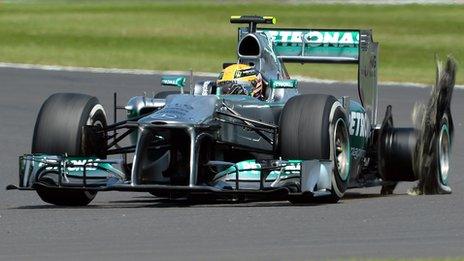
- Published1 July 2013
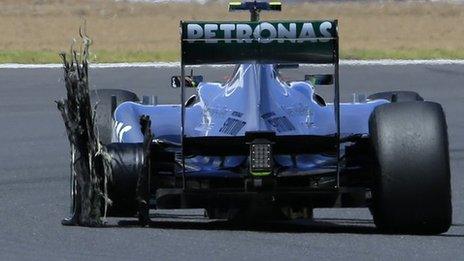
- Published30 June 2013
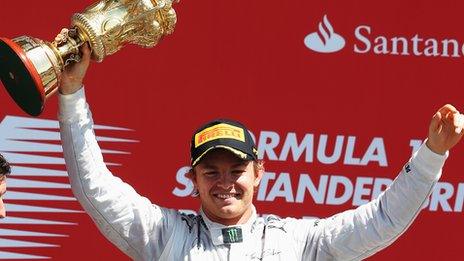
- Published30 June 2013

- Published30 June 2013
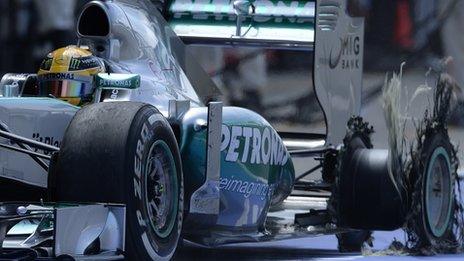
- Published30 June 2013

- Published29 June 2013

- Published29 June 2013
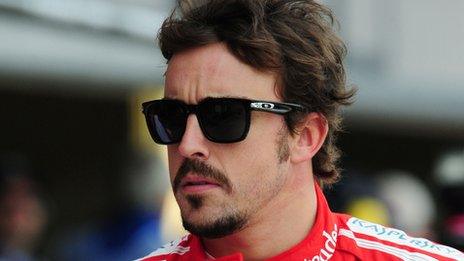
- Published28 June 2013
